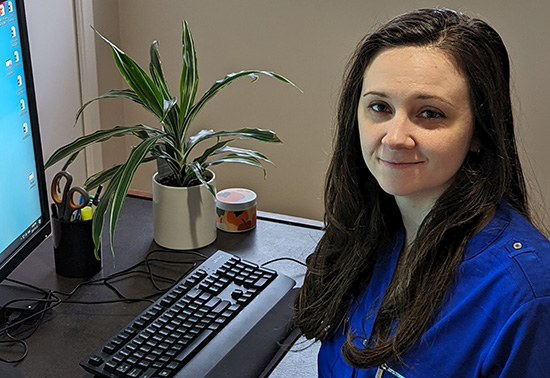Gazing into the COVID-19 crystal ball with Josée van den Hoogen, Defence Scientist
February 10, 2022 - Defence Stories

Caption
Defence Scientist Josée van den Hoogen is contributing to COVID-19 modelling at Defence Research and Development Canada’s Centre for Operational Research and Analysis.
If the COVID-19 pandemic has taught us anything, it is that it’s hard to predict the future, but for Defence Research and Development Canada (DRDC) scientist Josée van den Hoogen that challenge is part of her job in operational research.
While Josée did not initially envision a career in defence science, she was drawn to the opportunity to apply her research skills for the public good, and ultimately, for the benefit of the Department of National Defence (DND) and Canadian Armed Forces (CAF).
“If you have the chance to work in defence science, the people you meet and the experience you gain will set you up for future success,” she says.
Josée grew up in a small university town in rural Nova Scotia and completed her Bachelor of Science in mathematics, statistics and computer science from Saint Francis Xavier University in Antigonish. After she completed her Master of Science degree in mathematics and statistics from Queen’s University in Kingston, Ontario, she could not resist the draw back to the East Coast where she has been working out of Halifax, Nova Scotia as a junior defence scientist for nearly three years.
In her current role, Josée provides decision support to the CAF in the form of developing models and tools to aid in the decision-making process. More recently, this work has shifted to collaborating with her DRDC colleagues to provide COVID-19 modelling support to estimate the prevalence of COVID-19 infections. This research helps inform CAF decision-makers who are responsible for bringing groups of military members together for operations and exercises such as Operation LASER and Exercise MAPLE RESOLVE. With a background in evolutionary medicine, a branch of mathematical epidemiology, Josée was able to apply her familiarity with models used in the field of epidemiology to COVID-19 modelling.
However, as Josée notes, there is no way to account for all aspects of the real world inside of a model. Since COVID-19 is still relatively new and continues to evolve, a key challenge has been continuously adapting the models to consider new information such as vaccination status and emerging COVID-19 variants.
Throughout the pandemic, Josée and her colleagues were able to come together at a time when everyone was forced to be apart. The geographically dispersed team at DRDC’s Centre for Operational Research and Analysis (CORA) found creative ways to collaborate and share files. During this time, a new dedicated team of scientists within CORA was created to support Canadian Forces Health Services (CFHS) full-time.
According to Josée, the best part of working at DRDC is interacting with various teams of amazing individuals across the organization.
“Working with people across Canada and around the world, and seeing the impact and value of our work in informing decisions that affect the lives of many individuals, has been extremely rewarding,” Josée says.